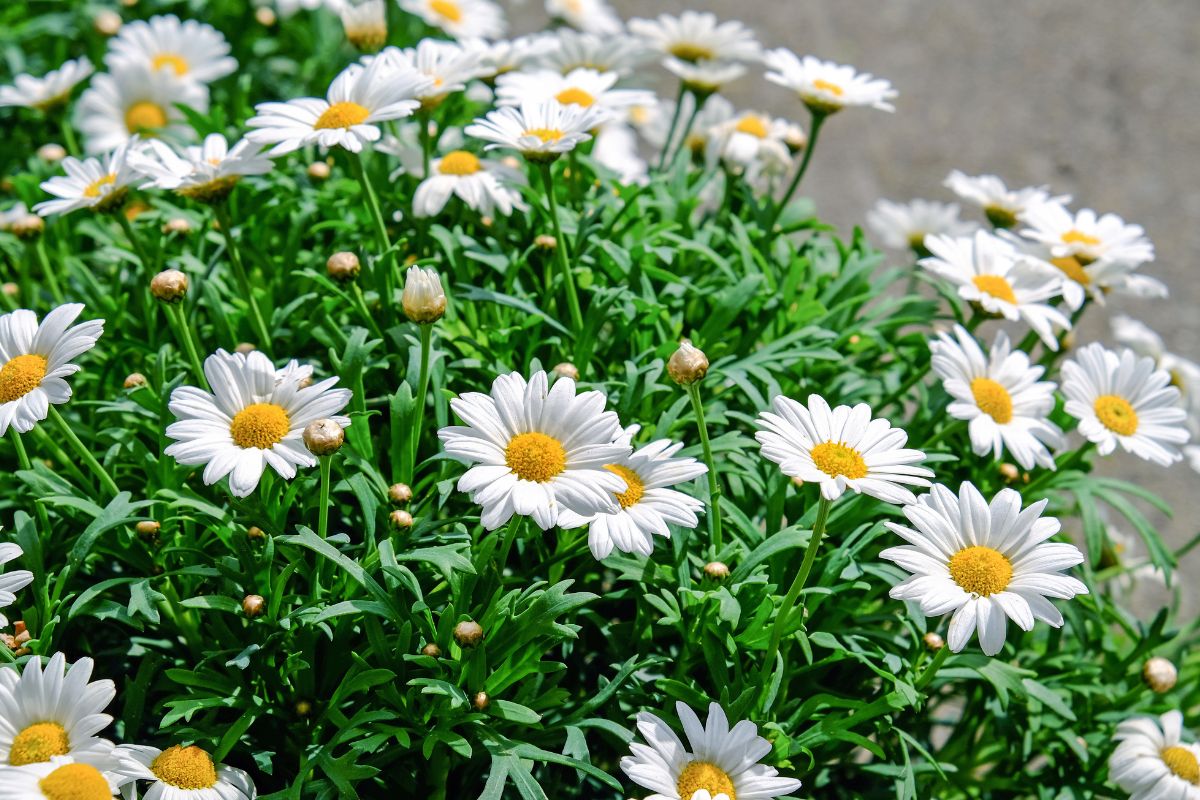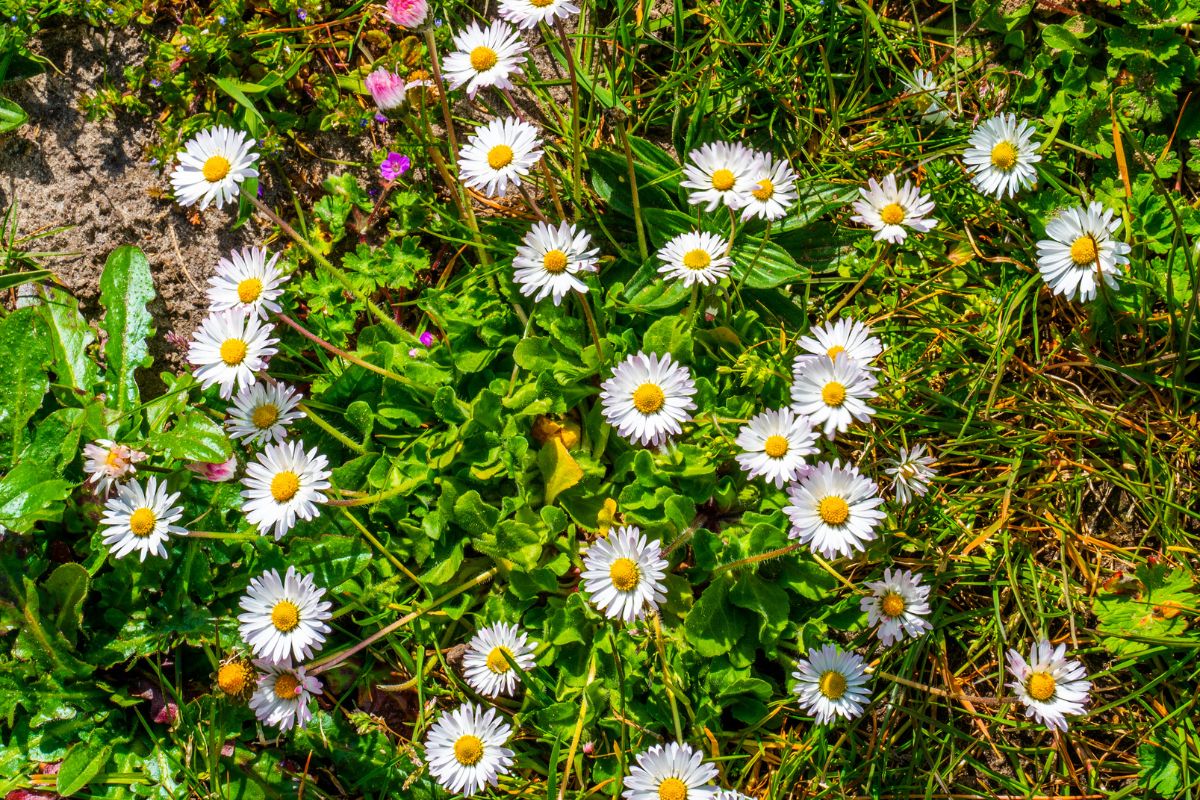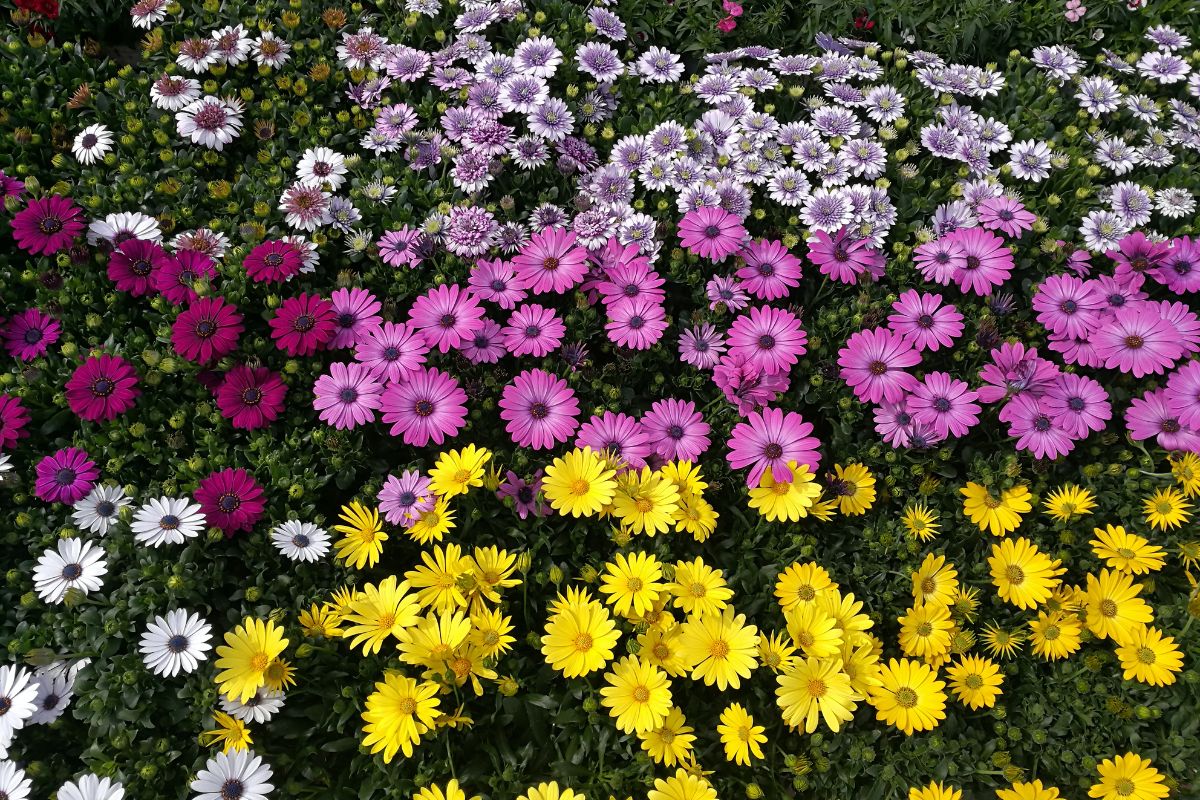Daisies are a classic flower, well known for their narrow petals and bold, bright core.
Most people know white daisies that have a yellow middle, but they also come in vivid shades of purple, pink, and yellow. These can have brown, green, and occasionally gold centers.

Most of the daisies you find in gardens around the globe come from the Asteraceae class. There are over 1,500 types which have around 23,000 kinds of daisies.
Every type has a slightly different appearance and particular, optimum growing conditions to survive.
If you want to grow daisies at home, it’s important to understand what zones they do best in, as well as how to look after them properly. For example, are daises perennials or annuals?
In short, daisies are usually undemanding perennials, though several are grown as annuals. A lot of these types are thought to be tender perennials, as they struggle to endure frost.
We’ll cover more about whether daisies are perennials or annuals in this post, as well as tips on growing each type to ensure success in your backyard.
Keep reading to discover more about daisies!
More About Daisies
Great for young children and beginner growers, daisies aren’t difficult to grow. All you need is a decent area of dirt, seeds, and some water. That’s it!
Practically all daisies can survive in regular gardening soil. You won’t even need a lot of water or fertilizer.
If you choose to grow daisies in containers, you’ll need an organic, light fertilizer, a nice amount of sunlight, and regular examination to make sure the roots drain well.
Daisies may be perennials, but they aren’t exactly eternal. They’ll look decent for two or three years, then will need a complete overhaul.
Daisies are self-seeding, so if you want to start some new blooms, you can divide them so they replant by themselves. Take care when doing this, as some varieties can take quickly take over your backyard.
Nevertheless, this is simple to control, as you can scrape them with a hoe, or coat them with mulch if you don’t want them to replant.
Daises can transplant easily, even during blooming time, as they can replant in other places with limited effort. The maintenance guidelines for daisies will differ based on whether you’re located up north, where frost can be an issue, or in a hotter climate.
The best advice for growing daisies also varies depending on the type of daisies you’re growing. Still, a lot of gardeners adore them as they can quickly dress up a garden, adding beautiful colors to your yard without a lot of work.
Daisy Hardiness Zones
Daisies can only grow as perennial flowers if they do well in their particular hardiness zones. You can grow them as perennials mainly in USDA hardiness zones 5 to 8. They flower from spring through until fall.
Daisies are still able to grow in perennials in different zones, but it does better in these zones. Several types of daisies originate from the U.S. and are common garden plants in their specific hardiness regions.
They don’t tolerate frost well and may struggle in temperatures beneath 30°F. For instance, golden daisies can do well in hardiness zones 3 and 4, in addition to ones 5 to 8. They can handle the first frost, but not for longer periods.
Gardeners can produce some types of daisies as annuals between USDA zones 9 and 10. This is because of the warmer conditions. They will only flower for a single season as there’s no cooldown resting stage.
The way you cultivate your daisies will vary based on your location and your aims. Some people choose to only produce them as annual plants, whereas others prefer to grow them as long-lasting flowers.

Developing Perennial Daisies
Shasta daisies are some of the most popular daisies that are grown as perennials. This is a hybrid plant that reaches between three and four feet in height. Gardeners are usually experienced with this type of daisy as it is very simple to grow.
Perennials like this daisy variety are available in bright shades of yellow and white, along with different kinds of petals.
Some dwarf perennial daisies reach between 8 and 12 inches tall. These small flowers look great on garden beds, while others create dense clusters that can be divided into portions.
The breed is cold-hardy and can be grown by planting the roots in a separate pot or growing it with its seeds.
Shasta daisies are a common perennial that grows best with medium light, damp soil, low fertilizer, and low water.
The stages for developing the flowers are practically the same ones used to cultivate annuals. The primary differences here are the flowering season’s length, as well as things to make the plants live through winter.
Cultivation Tips
If you’re planting perennial daisies in a pot, do so in spring or fall. The seeds can go out in fall, spring, and winter. Use sandy or average soil that drains well. The aim is to avoid them becoming dry, as they will wither and die during the season.
Keep watering the daisies frequently, but don’t overdo it. Constantly wet roots can cause fungal disease and root rot. This is why draining hole pots and well-draining soil is ideal.
Full sunlight is necessary when planting perennial daisies. They can handle light shade, but they won’t be as effective in producing flowers. Full sunlight means six to eight hours of sun.
If you are planting in a garden or flower bed, keep the daisies a minimum of 24 to 30 inches apart. This lets them transmit against different showy foliage.
The space also provides enough ventilation to pass through, helping to prevent fungus-related issues.
Developing Annual Daisies
If you are growing daisies that can form annually, like African or Marguerite daisies, they can be planted in a pot or a garden. These can form gorgeous flower borders in backyards, while some types can from their seeds.
Cultivation Method
Here are some steps to grow annual daisies from seeds.
It’s best to begin the daisy seeds inside between six and eight weeks before the growing season’s final frost.
Use a starter mix or potting soil to gently coat the seeds. Place them in a pot and keep them in a place where they can soak up a lot of sunlight.
You’ll need to keep watering them frequently and consistently, as this lets the soil remain damp. The seeds will need between 14 and 28 days to germinate.
After spring comes around, transfer the sprouted seeds to your backyard. When the final frost finishes, plant them in well-drained, fertile soil.
Position the plants between 12 and 15 inches away from each other. They will need room to grow, whether that be seeds or mature plant life.
If you want to improve your drainage, add a few inches of compost and mulch. This will supply the daisies with added nutrients.

Perennial Daisy Varieties
Here are some of the names of perennial daisies.
Leucanthemum x superbum – Shasta Daisy
Shasta daisies, as mentioned above, are what most people visualize as daisies. These have a vivid yellow core with bright, white petals around them.
Shasta daisies form abundantly in summer and are hardy between zones 4 and 9. They come in various sizes and heights. They also have different numbers of petals on each flower.
Shasta daisies always look amazing in cut flowerbeds and backyards.
Leucanthemum vulgare – Ox-eye Daisy
Ox-eye daisies have flowers that resemble traditional daisies, with a yellow center and white petals. These spread without much effort and can liven up many cottage scenes.
Every stalk forms two or more blooms, which can reach between one and two inches wide. This perennial daisy is hardy between zones 3 and 8.
Bellis Perennis – English Daisy
English daisies have small flowers that are a pleasant supplement to containers and rock gardens.
These are cool season blooms that work well with pansies, ornamental cabbage, and mums, creating fall-appropriate decor for your home.
English daisies are hardy between zones 4 and 8.
Tanacetum coccineum – Painted Daisy
Painted daisies have yellow cores and red, white, or pink petals. These look great in cottage homes and garden beds, adding color to scenes between summer and early fall.
Their foliage is fragrant and feathery, giving gardens a nice surface feel when the plants are not flowering.
This perennial daisy is hardy between zones 3 and 7.
Annual Daisy Varieties
Here are some of the names of annual daisies.
Argyranthemum frutescens – Marguerite Daisy
Originally from the Canary Islands, this type of daisy is, strictly speaking, a tender perennial. Marguerite daisies are cultivated as annual as they are solely hardy in zones 10 and 11.
These daisies can be grown throughout the year in Florida and southern California. The daisies can be cut back after flowering for another display of color.
Marguerite daisies are typically grown as an annual in colder conditions. This livens up fall backyards with color as the daisy flowers in colder seasons.
Osteospermum spp. – African Daisy
African daisies open up bright blooms every morning. The flowers have a little ‘eye’ at their core, with distinct exterior petals in vivid shades.
African daisies are available in many warm colors, like yellow and red, as well as bold ones, like purple and white.
Gerbera jamesonii – Gerbera Daisy
These annual daises are known for their bold, intense colors of yellow, bright pink, and orange. These beautiful shades dress up large flower heads for amazing bouquets.
Gerbera daisies were first located in Africa and are hardy between zones 9 and 11. They are a great choice for container gardens, as well as for anyone that wants more butterflies in their garden.
What Type Of Daisy Is Easier To Grow?
Perennial daisies are the easiest type to grow. After they have been developing in your backyard, the only upkeep required is deadheading dead blooms.
You won’t need to fertilize every year as perennial daisies can handle inadequate soil circumstances. YOu may need to stake a few taller types of daisies, as this prevents them from drooping over as they flower.
Annual daises need a lot of maintenance. You’ll need to water regularly, fertilize to keep them flowering and deadhead any faded blooms.
The daises also need replacing when the growing season finishes, as this ensures they’ll grow in your backyard again the following year.
When cared for properly, annual daisies do deliver bold color all season, unlike perennial ones that only deliver color for a particular season.
Nevertheless, for the most part, perennial daisies are a lot easier to grow.
Final Thoughts
Daisies are mainly perennial plants, but some varieties are cultivated as annuals. If you’re trying to choose whether to grow annuals or perennials, think about your location’s climate, as well as the requirements of your chosen daisy.
No matter which type you choose, stick to guidelines regarding light, watering, soil requirements, and spacing. This will make sure that your daisies turn out healthy and vibrant.
We hope you enjoyed learning more about daisies and consider adding them to your backyard!
- Interesting Flowers That Start With A - July 21, 2023
- Interesting Flowers Beginning With H - July 21, 2023
- 14 Fascinating Flowers That Begin With C - July 20, 2023
